Many kanji have subtle differences that may be confused or not noticed, especially if they are printed or written small, and even more so if you happen to have studied reading kanji but not writing them. It’s no secret that recognition is far easier than producing– and it’s not uncommon for someone who’s only studied reading and never writing to recognize 2,000 characters but only be able to write a fraction of them. One of the major reasons why it’s important to practice handwriting is to pick up on these subtleties.
A (somewhat lame) example could be, everyone can recognize the Mona Lisa, but unless practiced in producing it, you probably can’t mimic a copy to the point where someone recognizes it. Fortunately writing one character isn’t remotely as difficult or time consuming as reproducing the Mona Lisa, but hopefully it demonstrates the point!
Here are 15 sets of easily confused Japanese characters:
-
シ vs. ツ(‘shi’ vs. ‘tsu’)
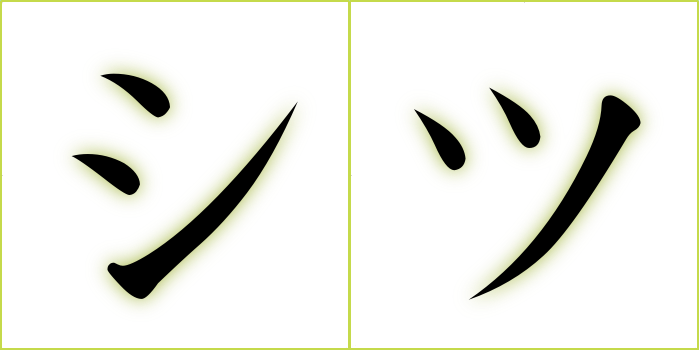 The font in the graphic shows the difference more clearly, and the stroke order is significantly different depending on which you write. In シ (left), the order is small dashes first, top to bottom, then the long dash written from bottom to top. In ツ (right), the order is small dashes first, bottom to top, then the long dash written from top to bottom. One trick for most handwriting and fonts would be to imagine a clock, and visualize which hour the third stroke is pointing toward. For instance, シ points more towards 4 o’clock, and ツ points more towards 2 o’clock.
The font in the graphic shows the difference more clearly, and the stroke order is significantly different depending on which you write. In シ (left), the order is small dashes first, top to bottom, then the long dash written from bottom to top. In ツ (right), the order is small dashes first, bottom to top, then the long dash written from top to bottom. One trick for most handwriting and fonts would be to imagine a clock, and visualize which hour the third stroke is pointing toward. For instance, シ points more towards 4 o’clock, and ツ points more towards 2 o’clock. -
ソ vs. ン(‘so’ vs. ‘n’)
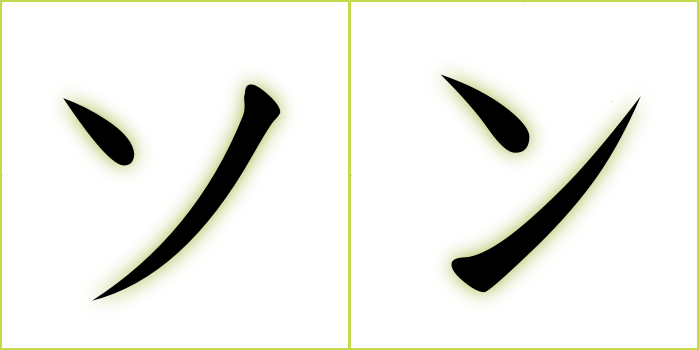 Both stroke orders are the same for these, except ソ (left) is written with the second stroke from top to bottom, while ン (right) is written with the second stroke bottom to top. The same trick can be used as the first set of characters above, where ソ is pointing more towards 2 o’clock, and ン points more towards 4 o’clock.
Both stroke orders are the same for these, except ソ (left) is written with the second stroke from top to bottom, while ン (right) is written with the second stroke bottom to top. The same trick can be used as the first set of characters above, where ソ is pointing more towards 2 o’clock, and ン points more towards 4 o’clock. -
入 vs. 人(‘enter’ vs. ‘person)
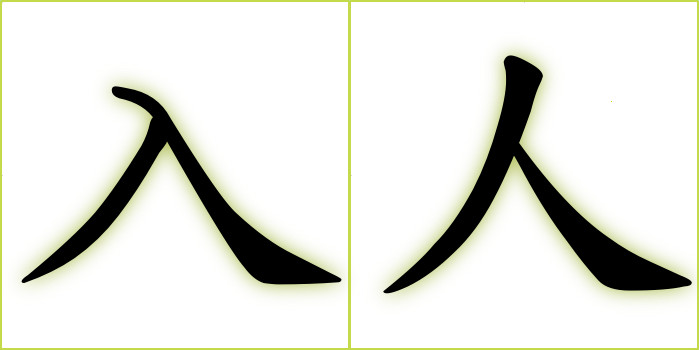 These are quite similar, with 入 (left) having the second stroke overlapping and longer than the first, and 人 (right) having the first stroke overlapping and the second stroke shorter. With a lot of fonts these characters look almost identical, with the exception of the strong hook shape at the top of 入.
These are quite similar, with 入 (left) having the second stroke overlapping and longer than the first, and 人 (right) having the first stroke overlapping and the second stroke shorter. With a lot of fonts these characters look almost identical, with the exception of the strong hook shape at the top of 入. -
犬 vs. 太(‘dog’ vs ‘fat’)
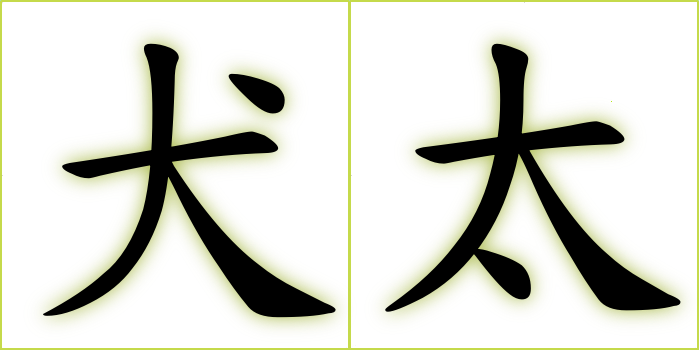 These characters could be tricky at first for a 漢字初心者 (kanji beginner). They’re both written almost the same way, with the difference being where the last dash is placed. 犬 (left) has it’s dash written in the upper right hand corner, while 太 (right) places the dash in the bottom center. If confusing at first, mnemonics can help– 犬 can be a *large* dog with a *drop* of drool from it’s mouth, and 太 can be a *large* (fat) sumo wrestler with a *drop* of loincloth between his legs.
These characters could be tricky at first for a 漢字初心者 (kanji beginner). They’re both written almost the same way, with the difference being where the last dash is placed. 犬 (left) has it’s dash written in the upper right hand corner, while 太 (right) places the dash in the bottom center. If confusing at first, mnemonics can help– 犬 can be a *large* dog with a *drop* of drool from it’s mouth, and 太 can be a *large* (fat) sumo wrestler with a *drop* of loincloth between his legs. -
捨 vs. 拾〔’discard’ vs. ‘pick up’)
 It’s no coincidence these two look so similar. 捨 (left) means “discard”, while 拾 (right) means “pick up” or “gather”. Besides the verb stems when used, which would be 捨てる and 拾う, mnemonics can be used to keep the two straight. With 捨, the ground component is used (albeit within 舎), which could be used to remember discarding something on the ground. With 拾, the 合 component is used which in 合う means to “merge” or “come together”, like picking something up.
It’s no coincidence these two look so similar. 捨 (left) means “discard”, while 拾 (right) means “pick up” or “gather”. Besides the verb stems when used, which would be 捨てる and 拾う, mnemonics can be used to keep the two straight. With 捨, the ground component is used (albeit within 舎), which could be used to remember discarding something on the ground. With 拾, the 合 component is used which in 合う means to “merge” or “come together”, like picking something up. -
未 vs. 末(‘not yet’ vs ‘end’)
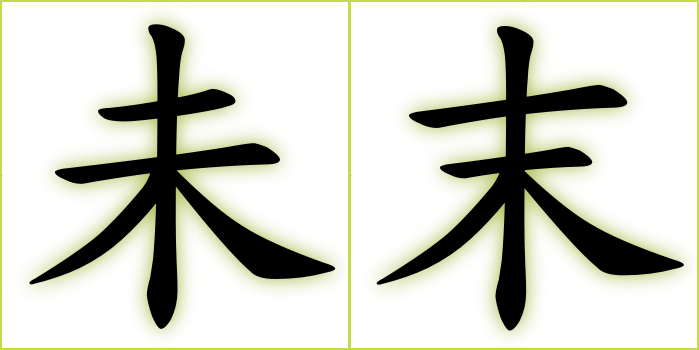 The character 未 (left) has it’s first stroke shorter than the second, while 末 (right) has it’s second stroke shorter than it’s first. Besides this subtle difference the characters are written the same way. One way to keep track of these while reading is to keep in mind that 未 (left) is a prefix, like in 未読 meaning “unread”, and 末 (right) is a suffix, like in 週末 meaning “weekend”.
The character 未 (left) has it’s first stroke shorter than the second, while 末 (right) has it’s second stroke shorter than it’s first. Besides this subtle difference the characters are written the same way. One way to keep track of these while reading is to keep in mind that 未 (left) is a prefix, like in 未読 meaning “unread”, and 末 (right) is a suffix, like in 週末 meaning “weekend”. -
緑 vs. 縁(‘green’ vs ‘fate/link’)
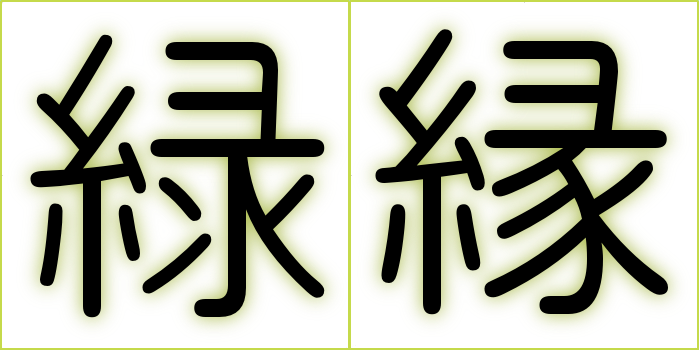 These are the same, except 緑 (left) uses 水 for the last portion of the character, while 縁 (right) uses 豕.
These are the same, except 緑 (left) uses 水 for the last portion of the character, while 縁 (right) uses 豕. -
宇 vs. 字(‘eaves’ vs ‘character’)
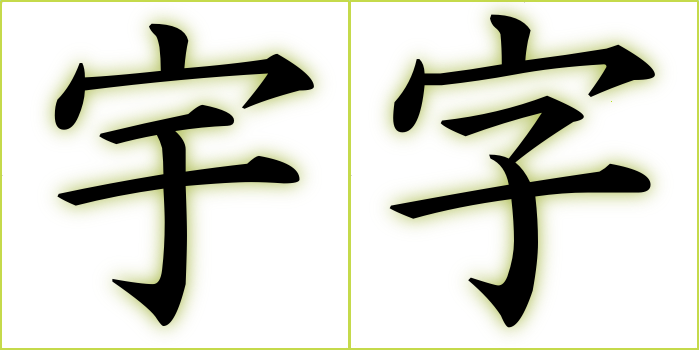 The character 宇 (left) uses 于, while 字 (right) uses 子. You’ll likely run into the character 宇 most often in the word 宇宙, meaning “universe”.
The character 宇 (left) uses 于, while 字 (right) uses 子. You’ll likely run into the character 宇 most often in the word 宇宙, meaning “universe”. -
鳥 vs. 烏
(‘bird’ vs ‘crow’)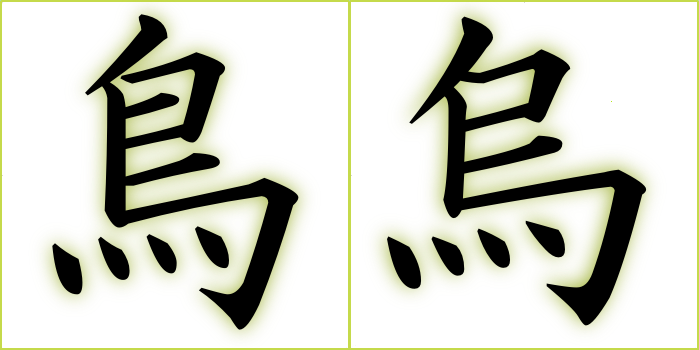 These two are purposefully similar, with the difference being that 鳥 (right) has one extra line compared to 烏 (left). With that said, the word for crow nowadays is typically written as カラス, in katakana.
These two are purposefully similar, with the difference being that 鳥 (right) has one extra line compared to 烏 (left). With that said, the word for crow nowadays is typically written as カラス, in katakana. -
土 vs. 士(‘ground’ vs ‘warrior’)
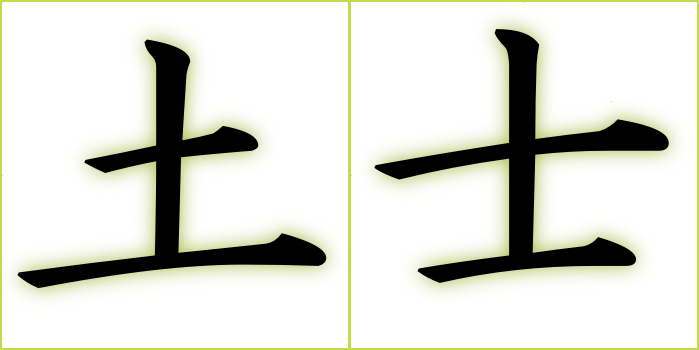 The proportions are what make these two different, other than that the strokes and order are the same. 土 (left) has a short first stroke, and a longer last stroke. 士 (right) has a long first stroke, and a shorter last stroke. 士 is also used most commonly as a suffix, like in 兵士 meaning “soldier”.
The proportions are what make these two different, other than that the strokes and order are the same. 土 (left) has a short first stroke, and a longer last stroke. 士 (right) has a long first stroke, and a shorter last stroke. 士 is also used most commonly as a suffix, like in 兵士 meaning “soldier”. -
候 vs. 侯(‘season/weather’ vs. ‘lord/daimyo’)
 These two aren’t just visually similar, but also phonetically identical (no surprise as the right phonetic-half is the same). The first character 候 (left) has an extra stroke (third), and 侯 (right) lacks the stroke.
These two aren’t just visually similar, but also phonetically identical (no surprise as the right phonetic-half is the same). The first character 候 (left) has an extra stroke (third), and 侯 (right) lacks the stroke. -
幸 vs. 辛(’happiness’ vs ‘bitter/spicy’)
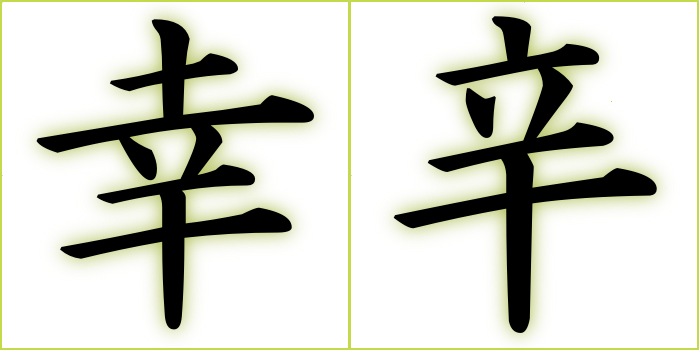 It’s interesting the difference between 幸 (left) meaning “happiness”, and 辛 (right) meaning “bitter” is just one line.
It’s interesting the difference between 幸 (left) meaning “happiness”, and 辛 (right) meaning “bitter” is just one line. -
氷 vs. 永(‘ice’ vs ‘eternity’)
 氷 (left) has it’s dash (third stroke) in the upper left hand corner, while 永 has it’s dash (first stroke) at the upper middle. The other difference besides the placement and stroke order of the dash is the hook shape at the top of 永’s second stroke.
氷 (left) has it’s dash (third stroke) in the upper left hand corner, while 永 has it’s dash (first stroke) at the upper middle. The other difference besides the placement and stroke order of the dash is the hook shape at the top of 永’s second stroke. -
日 vs. 曰〔’day/sun’ vs ‘pretext/say’)
 The only difference in these are the proportions of how they’re drawn. 日 (left) is drawn taller, while 曰 (right) is drawn wider. You’ll probably run into the second character most often in the word 曰く, meaning “pretext; history; story”, or “says”.
The only difference in these are the proportions of how they’re drawn. 日 (left) is drawn taller, while 曰 (right) is drawn wider. You’ll probably run into the second character most often in the word 曰く, meaning “pretext; history; story”, or “says”. -
垂 vs. 重(‘suspend/hang’ vs ‘heavy’)
 These two are definitely different, however when printed small could easily be confused.
These two are definitely different, however when printed small could easily be confused.
Are there any not listed here that you find easy to confuse? Let us know in the comments!
